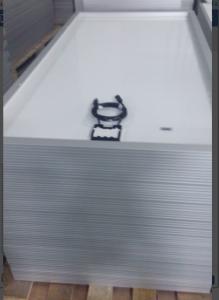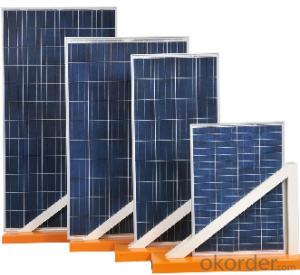Inlay Solar Panels 250w Polycrystalline Solar Panel Made in China
- Loading Port:
- Shanghai
- Payment Terms:
- TT OR LC
- Min Order Qty:
- 100 watt
- Supply Capability:
- 10000 watt/month
OKorder Service Pledge
OKorder Financial Service
You Might Also Like
Specification
Product Description
Produt name: 250W Poly Crystalline Solar Panel
Product Highlights:
1. Guarantee positive power tolerance (0~+3%)
2. Module can bear snow loads up to 5400Pa and wind loads up to 2400pa
3. High performance under low light conditions (cloudy days, mornings and evenings)
4. Certified by Europe standards of TUV, IEC, CE and British MCS and AUS CEC
5. OEM/ODM available
Specification:
| Electrical Characteristics | |
| Maximum Power [Pmax] | 250W |
| Power Tolerance | +/-3% |
| Maximum Power Voltage [Vmp] | 30.1V |
| Maximum Power Current [Imp] | 8.31A |
| Short-Circuit Current [Isc] | 8.73A |
| Open-Circuit Voltage [Voc] | 37.3V |
| Module Efficiency | 15.37% |
| Max. System Voltage | 1000VDC |
| Cell Size and Series | Poly 156*156 60pcs (6*10) |
| Temperature Coefficient of Pmax | - 0.47% / º C |
| Temperature Coefficient of Voc | - 0.35% / º C |
| Temperature Coefficient of Isc | 0.05% / º C |
| Mechanical Characteristics | |
| Dimension (mm) | 1640*992*40 |
| Frame | Anodized Aluminium Alloy |
| Glass | 3.2mm,High Transmission,Tempered Glass |
| Junction box & Cable | IP65 Rated weatherproof connectors Cable: TUV 1x4.0mm2 / UL12AWG,Length:900mm |
| Weight | 19.0Kgs |
Industry-leading Warranty:
Warranty on material and workmanship: 10 years
Guaranteed output of 90% after 12 years and 80% after 25 years.
Application:
Poly 250W Panels in 1MW CGC PV Demonstration Project
The Future Looks Brighter with Us!
- Q: if you move a solar panel or there was a vibration that caused the panel to move, would that affect it?
- No. I've got one on top of my RV and taking it down the road at 70mph doesn't hurt it at all.
- Q: Didnt solar panels use to cost around $250,000 5 years ago?
- For just 5 years ago, certainly not! Perhaps you are thinking of 50 years ago, the kind that was put on the early communication satellites? 5 years ago, there was a glut of polysilicon, so modules were actually a little cheaper than today. Solar cell makers were basically using the scraps thrown away by chipmakers. But today, more silicon goes into making solar cells than computer chips, so that bonanza is gone. We will see prices going lower this year, possibly 20% from last year, because of improvements in technology, but also an increase in polysilicon supply, and a slowdown in demand due to worldwide recession. Later this year is a good time to buy panels, if you have the cash. The industry site below tracks module prices. They used to have more data, but I guess the old data rolls off the screen with time. If you want to see the details, they'll charge you for the report.
- Q: Can solar panels be used in urban areas with limited space?
- Yes, solar panels can definitely be used in urban areas with limited space. There are various innovative solutions available such as rooftop solar panels, solar panels integrated into building facades, and even solar panels installed on vertical structures like lamp posts or noise barriers. These compact and versatile options allow urban areas to harness solar energy efficiently, even with limited space.
- Q: Can solar panels be installed on a warehouse or distribution center?
- Yes, solar panels can be installed on a warehouse or distribution center. In fact, these large, flat rooftops are often ideal locations for solar panel installations due to the ample space available for positioning the panels. The electricity generated by the solar panels can be used to power the operations of the warehouse or distribution center, reducing reliance on traditional energy sources and decreasing carbon emissions.
- Q: Can solar panels be installed on a mobile home?
- Yes, solar panels can be installed on a mobile home. In fact, mobile homes are an excellent candidate for solar panel installation due to their flexibility and relatively small energy demands. The panels can be mounted on the roof or on a ground-mounted system nearby, providing clean and renewable energy to power the home.
- Q: Can solar panels be installed in urban areas?
- Yes, solar panels can be installed in urban areas. In fact, urban areas provide great opportunities for solar panel installations due to the abundance of rooftop space and potential to generate clean energy in densely populated areas.
- Q: How do solar panels affect insurance rates?
- Solar panels can generally have a positive impact on insurance rates. While the installation of solar panels may slightly increase the dwelling coverage, the potential savings on electricity bills and the added value to the property can often outweigh any additional costs. Additionally, some insurance companies offer specialized policies and discounts for homes with solar panels, making it a favorable choice for homeowners.
- Q: thinking of getting a portable solar panel laptop charger...may be a stupid question but may be a very intelligent one as well ;)
- As long as the solar panel has access to light it will operate. If you can keep it in the sunlight it will work a lot better than off the internal lights on the plane. Depending on the plane/lighting/your position, there might not be enough ambient light available for the solar panels to run your laptop.
- Q: I own a townhome in the Phoenix area (my power company's SRP, if that makes a difference). Phoenix is a great place for solar. I could probably save money, in the long term, if I got some solar panels.But I am currently extremely broke, so I can't buy solar panels unless I will more or less immediately be paying no more than I am now per month, with little or nothing down. And most of the solar leasing places won't work with me, because (as is common for townhomes) I don't technically own my roof. I have permission to put things on it, but the property management people (or whoever actually owns my roof) won't sign the lease or whatever.Anyone know of either a way to buy solar panels without paying significantly more per month than I already do for electricity, or a solar leasing company that can work with the restrictions I have?
- There are companies who would install solar panels on your roof for no cost. The catch is that they get the power generated for the first 20 years which is the useful life of the panels then you get what's left of the obsolete panels, meanwhile you're required to purchase your power from them at allegedly reduced rates but there is no guarantee that they would remain reduced versus the market once they have you locked in. It's like how the cell phone companies will give you a free cell phone if you sign a contract. Keep in mind that once you've factored in the installation costs and the useful life of the panels, the effective costs of solar photovoltaic energy is about 23 cents to 43 cents a kwh while grid power is about 5 cents per kwh to the consumer, 3 cents per kwh to the utilities for coal generation. It's just that so few people understand how to project an initial capital expense with periodic future returns through discounted cash flow, hence people think solar power is free out of ignorance. Without government incentives, there are no economic benefits to solar and most solar installers structure the sales such that they gain the economic benefit instead of the consumer who is often ignorant of how to calculate the financials.
- Q: it is just for a simple project, but i am looking for a cheap, low cost, around one to two volts solar panel regulator uld y'all please help?
- try OKorder..i know it sounds corney but someone might be selling one, if not try your nearest hardware store? Like ..lowes..orsomething.
Send your message to us
Inlay Solar Panels 250w Polycrystalline Solar Panel Made in China
- Loading Port:
- Shanghai
- Payment Terms:
- TT OR LC
- Min Order Qty:
- 100 watt
- Supply Capability:
- 10000 watt/month
OKorder Service Pledge
OKorder Financial Service
Similar products
Hot products
Hot Searches
Related keywords




























